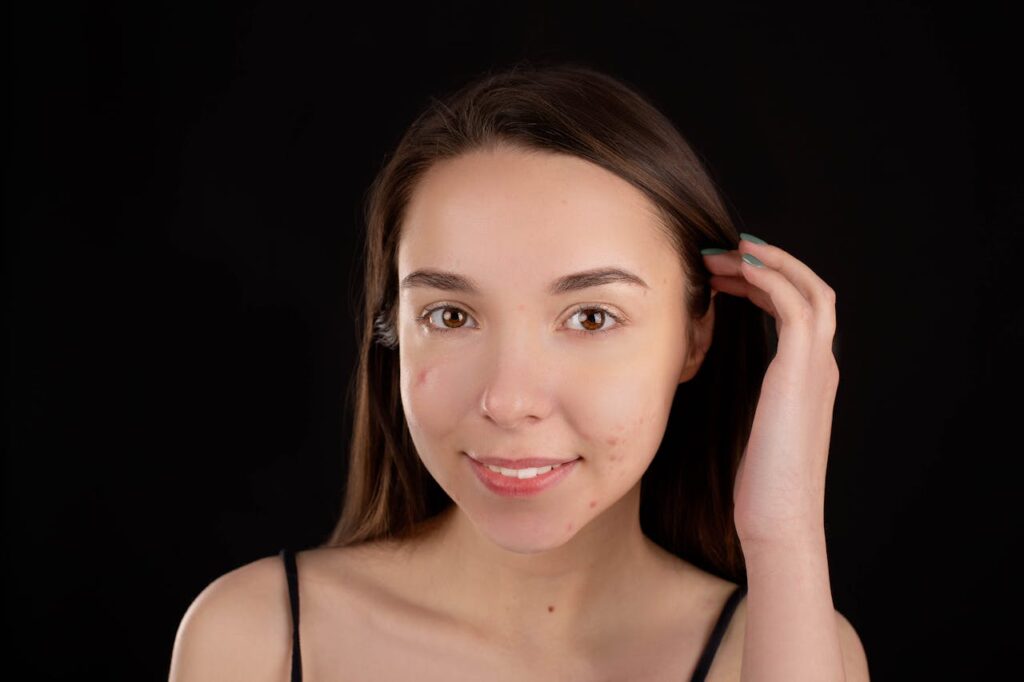If you’ve ever noticed breakouts appearing after an intense workout or during hot summer days, you’re not alone. Sweat pimples, medically known as acne mechanica, are a common skin concern that affects millions of people who lead active lifestyles or live in humid climates. Understanding what causes these frustrating breakouts and how to prevent them can help you maintain clear, healthy skin year-round.
What Are Sweat Pimples?
Sweat pimples are a specific type of acne that develops when sweat, heat, friction, and bacteria combine to clog your pores. Unlike regular acne that primarily affects the face, sweat pimples typically appear in areas where sweat accumulates or where clothing creates friction against the skin.
The Science Behind Sweat Acne
When you sweat, your body produces a natural antimicrobial substance called dermcidin, which helps fight acne-causing bacteria. However, excessive sweating can disrupt this protective mechanism, creating an environment where harmful bacteria like Propionibacterium acnes can thrive. The combination of sweat, dead skin cells, and sebum (natural skin oil) creates the perfect storm for clogged pores.
Common Areas Affected by Sweat Pimples
Sweat acne typically appears in areas prone to moisture buildup and friction:
- Chest and back: Where sweat accumulates and clothing rubs against the skin
- Shoulders: Especially under sports bra straps or tight-fitting tops
- Forehead and hairline: Where sweat drips and headbands create friction
- Buttocks and thighs: From tight workout clothes and prolonged sitting
- Under arms: Where deodorant, sweat, and friction combine
What Do Sweat Pimples Look Like?
Sweat pimples can manifest in several forms, making them sometimes difficult to distinguish from other skin conditions:
- Small, red bumps: Similar to regular acne but often clustered in sweaty areas
- Whiteheads and blackheads: Caused by completely or partially blocked pores
- Inflamed pustules: Red, tender bumps with white or yellow centers
- Papules: Small, hard bumps without visible pus
The key distinguishing factor is their location – sweat pimples appear where you sweat most or where clothing creates friction, rather than in the typical T-zone areas of regular facial acne.
How to Treat Sweat Pimples
Effective treatment of sweat acne requires a gentle yet targeted approach that addresses both the immediate breakout and prevents future occurrences.
Gentle Cleansing Protocol
The foundation of sweat acne treatment is proper cleansing:
- Use a pH-balanced cleanser: Look for products with a pH between 4.5-6.5 to maintain your skin’s natural barrier
- Cleanse twice daily: Once in the morning and immediately after sweating
- Avoid harsh scrubbing: Gentle circular motions prevent further irritation
- Choose oil-free formulas: Non-comedogenic cleansers won’t clog pores
Topical Treatments
Several over-the-counter ingredients can effectively treat sweat pimples:
Salicylic Acid (0.5-2%)
- Penetrates pores to remove dead skin cells and excess oil
- Reduces inflammation and prevents new breakouts
- Best applied to clean, dry skin before moisturizer
Benzoyl Peroxide (2.5-5%)
- Kills acne-causing bacteria
- Reduces oil production
- Start with lower concentrations to avoid irritation
Retinoids
- Promote cell turnover and prevent clogged pores
- Available over-the-counter (retinol) or prescription-strength (tretinoin)
- Use at night and always follow with SPF during the day
Professional Treatment Options
For persistent or severe sweat acne, consider consulting a dermatologist for:
- Prescription topical treatments: Stronger retinoids, antibiotics, or combination therapies
- Oral medications: Antibiotics or hormonal treatments for severe cases
- Professional procedures: Chemical peels or light therapy
How to Prevent Sweat Acne
Prevention is always better than treatment when it comes to sweat pimples. A comprehensive prevention strategy addresses all the factors that contribute to breakouts.
Pre-Workout Prevention
Remove Makeup and Skincare Products
- Cleanse your face before exercising to remove makeup, sunscreen, and skincare products
- These can mix with sweat and clog pores during your workout
Choose the Right Clothing
- Wear clean, breathable fabrics like moisture-wicking polyester or bamboo
- Avoid cotton, which retains moisture and bacteria
- Ensure proper fit – not too tight or too loose
Apply Appropriate Sun Protection
- Use oil-free, non-comedogenic SPF 30+ for outdoor activities
- Look for zinc oxide or titanium dioxide-based formulas
During Exercise Prevention
Manage Sweat Effectively
- Use clean towels to gently pat (never rub) sweat from your skin
- Change towels frequently during long workouts
- Avoid touching your face with sweaty hands
Equipment Hygiene
- Wipe down shared gym equipment before and after use
- Bring your own yoga mat and towels when possible
- Avoid sharing helmets, headbands, or other personal equipment
Post-Workout Care
Immediate Cleansing
- Shower within 30 minutes of finishing your workout
- Use lukewarm water and a gentle, oil-free cleanser
- Pay special attention to areas prone to sweat acne
If You Can’t Shower Immediately
- Change out of sweaty clothes as soon as possible
- Use salicylic acid wipes or pads on affected areas
- Apply a light, oil-free moisturizer to prevent over-drying
Sweat Acne vs. Other Skin Conditions
Understanding the difference between sweat acne and similar conditions ensures you choose the right treatment approach.
Heat Rash (Miliaria)
Miliaria Crystallina
- Small, clear, fluid-filled bumps
- No inflammation or redness
- Resolves quickly when skin cools
Miliaria Rubra
- Red, itchy bumps
- More inflammatory than sweat acne
- Often accompanied by prickly sensation
Folliculitis
- Infection of hair follicles
- Often has a white or yellow pustule at the center
- May be caused by bacteria, fungi, or ingrown hairs
- Requires different treatment than acne
Grover’s Disease
- Typically affects older adults
- Appears as itchy, red spots on the chest and back
- Often triggered by heat and sweating
- Requires dermatological diagnosis and treatment
Seasonal and Environmental Factors
Summer Sweat Acne Management
Hot, humid weather presents unique challenges for acne-prone skin:
- Increase cleansing frequency: You may need to cleanse more than twice daily
- Adjust your skincare routine: Use lighter, gel-based products
- Stay hydrated: Proper hydration helps regulate body temperature and sweat production
- Seek air conditioning: When possible, cool down in air-conditioned spaces
Different Exercise Types and Skin Impact
High-Intensity Workouts
- Produce more sweat and require immediate post-workout care
- Consider shorter, more frequent cleansing sessions
Swimming
- Chlorine can be drying but also antibacterial
- Always rinse immediately after swimming
- Use a gentle, hydrating cleanser
Outdoor Activities
- Combine sweat with environmental pollutants
- Require thorough cleansing and sun protection
Hormonal Factors and Sweat Acne
Hormonal fluctuations can worsen sweat acne, particularly:
- During menstrual cycles: Increased oil production can exacerbate breakouts
- Pregnancy: Hormonal changes may increase acne susceptibility
- Stress: Elevates cortisol levels, which can worsen acne
- Puberty: Increased hormone production affects both regular and sweat acne
Dietary Considerations
While diet doesn’t directly cause sweat acne, certain foods may worsen breakouts:
- High-glycemic foods: May increase inflammation and oil production
- Dairy products: Some studies suggest a link to acne in certain individuals
- Processed foods: Can contribute to overall inflammation
Focus on an anti-inflammatory diet rich in:
- Omega-3 fatty acids
- Antioxidant-rich fruits and vegetables
- Whole grains and lean proteins
Long-Term Management Strategies
For those prone to chronic sweat acne, developing a sustainable routine is crucial:
Building Your Routine
- Establish consistent cleansing habits: Make post-workout cleansing non-negotiable
- Invest in quality workout gear: Moisture-wicking, antimicrobial fabrics are worth the investment
- Monitor your triggers: Keep a skin diary to identify patterns
- Regular dermatological check-ups: Professional guidance can prevent minor issues from becoming major problems
Product Recommendations by Skin Type
Oily Skin
- Gel-based cleansers with salicylic acid
- Oil-free, mattifying moisturizers
- Clay masks once or twice weekly
Sensitive Skin
- Fragrance-free, gentle cleansers
- Hypoallergenic, mineral-based products
- Patch test new products before full application
Combination Skin
- Different products for different areas
- Lighter formulations for oily zones
- More hydrating products for dry areas
When to See a Dermatologist
Consult a professional if you experience:
- Persistent breakouts despite consistent prevention efforts
- Severe inflammation or cystic acne
- Scarring from previous breakouts
- Signs of infection (increased redness, warmth, pus)
- Emotional distress related to your skin condition
Frequently Asked Questions
Q: Can I still exercise if I have sweat acne?
A: Absolutely! Exercise is beneficial for overall health and can actually improve circulation and stress levels, which may help your skin. The key is proper hygiene before, during, and after your workout.
Q: How long does it take for sweat acne to clear up?
A: With consistent treatment and prevention measures, you should see improvement within 4-6 weeks. However, individual results vary based on severity and skin type.
Q: Is it better to shower with hot or cold water after working out?
A: Lukewarm water is ideal. Hot water can irritate inflamed skin and strip natural oils, while very cold water may not effectively remove sweat and bacteria.
Q: Can certain fabrics make sweat acne worse?
A: Yes, cotton and other moisture-retaining fabrics can worsen sweat acne. Choose moisture-wicking synthetic fabrics or natural fibers like bamboo that have antimicrobial properties.
Q: Should I use the same acne products for sweat pimples as regular acne?
A: Many of the same ingredients work for both types of acne, but sweat acne may require more frequent cleansing and attention to friction-prone areas.
Take Control of Your Skin Health
Sweat pimples don’t have to derail your fitness goals or summer activities. By understanding the causes, implementing proper prevention strategies, and maintaining consistent treatment when needed, you can enjoy an active lifestyle while keeping your skin clear and healthy.
Remember that everyone’s skin is different, and what works for one person may not work for another. Be patient with your skin, stay consistent with your routine, and don’t hesitate to seek professional help when needed. With the right approach, you can say goodbye to sweat pimples and hello to confident, clear skin – no matter how much you sweat.
Start implementing these strategies today, and give your skin the care it deserves. Your future self will thank you for taking proactive steps toward healthier, clearer skin.



